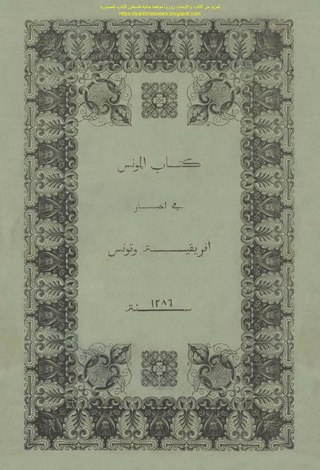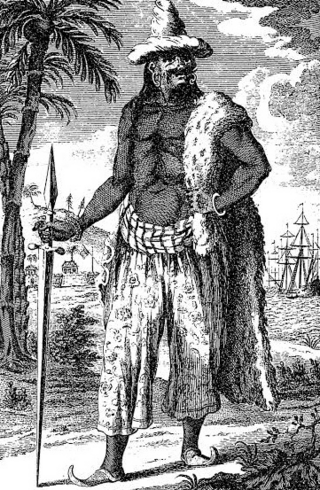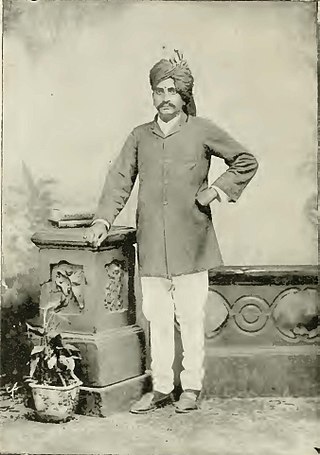Related Research Articles
Robert Culliford was a pirate from Cornwall who is best remembered for repeatedly checking the designs of Captain William Kidd.

Maritime powers in the Indian subcontinent have possessed navies for many centuries. Indian dynasties such as the Chola Empire used naval power to extend their influence overseas, particularly to Southeast Asia. The Marakkar Navy under Zamorins during 15th century and the Maratha Navy of the Maratha Empire during the 19th and 18th centuries fought with rival Indian powers and European powers. The East India Company organised its own private navy, which came to be known as the Bombay Marine. With the establishment of the British Raj after the Indian Rebellion of 1857, the small navy was transformed into "His Majesty's Indian Navy", then "Her Majesty's Indian Marine", and finally the "Royal Indian Marine".

Kanhoji Angre, also known as Conajee Angria or Sarkhel Angré was a chief of the Maratha Navy in present-day India. Kanhoji became known for attacking and capturing European merchant ships and collecting jakat, seen by Europeans traders and colonists as ransoming of their crews. British, Dutch and Portuguese ships often fell victims to these raids.Despite attempts by the Portuguese and British to put an end to his privateering activities, Angre continued to capture and collect jakat from European merchant ships until his death in 1729. Kanhoji's naval prowess in capturing dozens of European trading ships and avoiding capture has led to many historians to appraise Kanhoji as the most skilled Indian navy chief in the maritime history of India.

Edward "Ned" Low was a notorious pirate of English origin during the latter days of the Golden Age of Piracy, in the early 18th century. Low was born into poverty in Westminster, London, and was a thief from an early age. He moved to Boston, Massachusetts, as a young man. His wife died in childbirth in late 1719. Two years later, he became a pirate, operating off the coasts of New England and the Azores, and in the Caribbean.

Suvarnadurg is a fort that is located between Mumbai and Goa on a small island in the Arabian Sea, near Harnai in Konkan, along the West Coast of India, in the Indian state of Maharashtra.
Captain Samuel Burgess was a member of Captain William Kidd's crew in 1690 when the Blessed William was seized by Robert Culliford and some of the crew, with William May named as captain.

John Halsey was a British privateer and later a pirate who was active in the Atlantic and Indian Oceans during the early 18th century. Although much of his life and career is unknown, he is recorded in A General History of the Pyrates, which states "He was brave in his Person, courteous to all his Prisoners, lived beloved, and died regretted by his own People. His Grave was made in a garden of watermelons, and fenced in with Palisades to prevent his being rooted up by wild Hogs."
This timeline of the history of piracy in the 1640s is a chronological list of key events involving pirates between 1640 and 1649.

Siemen Danziger, better known by his anglicized names Zymen Danseker and Simon de Danser, was a 17th-century Dutch privateer and Barbary corsair based in Ottoman Algeria. His name is also written Danziker, Dansker, Dansa or Danser.
Jan Willems, also known as Janke or Yankey Willems, was a 17th-century Dutch buccaneer. Based out of Petit-Goâve, Willems participated in a number of expeditions against the Spanish during the early to mid-1680s with other well-known privateers including Michiel Andrieszoon, Thomas Paine, Laurens de Graaf, Nicholas van Hoorn and Michel de Grammont.

Khanderi is an island with a fort, located south of Mumbai, along the coast of Maharashtra, India.

Vijaydurg, the oldest fort on the Sindhudurg coast, was constructed during the regime of Raja Bhoja II of the Shilahar dynasty and restructured by Chhatrapati Shivaji Maharaj.

The English overseas possessions, also known as the English colonial empire, comprised a variety of overseas territories that were colonised, conquered, or otherwise acquired by the former Kingdom of England during the centuries before the Acts of Union of 1707 between the Kingdom of England and the Kingdom of Scotland created the Kingdom of Great Britain. The many English possessions then became the foundation of the British Empire and its fast-growing naval and mercantile power, which until then had yet to overtake those of the Dutch Republic, the Kingdom of Portugal, and the Crown of Castile.

The Republic of Pirates was the base and stronghold of a loose confederacy run by privateers-turned-pirates in Nassau on New Providence island in the Bahamas during the Golden Age of Piracy for about twelve years from 1706 until 1718. While it was not a republic in a formal sense, it was governed by an informal pirate code, which dictated that the crews of the Republic would vote on the leadership of their ships and treat other pirate crews with civility. The term comes from Colin Woodard's book of the same name.

The gallivat was a small, armed boat, with sails and oars, used on the Malabar Coast in the 18th and 19th centuries. The word may derive from Portuguese "galeota" or alternatively, from the Maratha "gal hat" ship. Hobson-Jobson has an extensive discussion of the origins of the term and its usage.

The Maratha Navy was the naval wing of the armed forces of the Maratha Empire, which existed from around the mid-17th century to the mid-18th century in the Indian subcontinent.

Tulaji Angre, called Tulajee Angria by English historians was the grand admiral of the Maratha Navy and ruler of Colaba State in modern-day India. Similar to his famous father Kanhoji Angre, he too was an extremely skilled admiral and attacked several European trading ships. His achievements and naval prowess are considered to be greater than that of his father by some scholars and chroniclers. On various occasions he fought against the English, Dutch, Siddis And Portuguese maritime Powers. However, he alienated himself from the Maratha Peshwa, Balaji Baji Rao which led to his capture by the East India Company and Peshwa's forces at the Battle of Vijaydurg in 1756.
Colaba State, also known as Culaba State or Angria's Colaba was a Kingdom and later princely state in India. It was founded by the famous Maratha Navy admiral Kanhoji Angre in 1698. The ruling family of the state, the Angre, were skilled seafarers who controlled the western coast of India from the late 17th century- to the first half of the 18th century, until the Maratha Peshwa Balaji Baji Rao destroyed the major portion of their navy in the Battle of Vijaydurg.

The Dhulap family was a Maratha noble family of the Maratha Empire in the late 18th century-early 19th century who were hereditary sarkhels or supreme commanders of the Maratha Navy during its decline. They came to power after the Angre family's downfall and Tulaji Angre's defeat at the Battle of Vijaydurg by the East India Company. Rudraji Dhulap and his son Anandrao Dhulap successively served as grand admirals of the Maratha Navy.
References
- ↑ Brown, George W.; David M. Hayne, Francess G. Halpenny and Ramsay Cook. Dictionary of Canadian Biography Vol. II. Toronto: Toronto University Press, 1966. (pg. 487) ISBN 0-8020-3240-0
- ↑ Fitzpatrick, William John. The Life, Times and Correspondence of the Right Rev. Dr. Doyle, Bishop of Kildare and Leighlin. Vol. I. Dublin: James Duffy, 1861. (pg. 5)
- ↑ Lorimer, George. "Lighthouses". The Windsor Magazine: An Illustrated Monthly for Men and Women . Vol. XXII (June–November), 1905. (pg. 275-276)
- ↑ Castillo, Dennis. The Maltese Cross: A Strategic History of Malta. Westport, Connecticut: Greenwood Publishing Group, 2006. (pg. 88) ISBN 0-313-32329-1
- ↑ Beal, Clifford. Quelch's Gold: Piracy, Greed, and Betrayal in Colonial New England. Westport, Connecticut: Greenwood Publishing Group, 2007. (pg. 201) ISBN 0-275-99407-4
- ↑ "Chapter VII. History. The Angrias, 1690-1840; Kanhoji Angria, 1690-1731". Gazetteer of the Bombay Presidency. Vol. XI. Bombay: Government Central Press, 1883.
- ↑ Brennan, Steve. The Gigantic Book of Pirate Stories. New York: Skyhorse Publishing, 2007. (pg. 140) ISBN 1-60239-156-4
- ↑ Booth, Mary L. History of the City of New York. New York: W.R.C. Clark, 1867. (pg. 287)
- ↑ Ober, Frederick A. Our West Indian Neighbors: The Islands of the Caribbean Sea. New York: James Pott & Company, 1912. (pg. 11)
- ↑ Woodard, Colin. The Republic of Pirates: Being the True and Surprising Story of the Caribbean Pirates and the Man Who Brought Them Down. Orlando, Florida: Harcort, 2007. (pg. 65-66) ISBN 0-15-101302-0